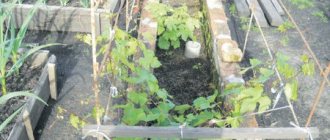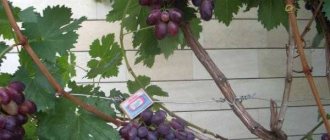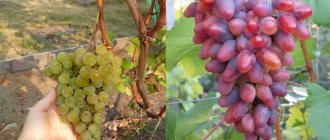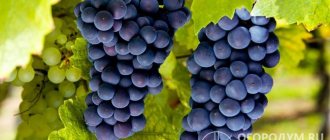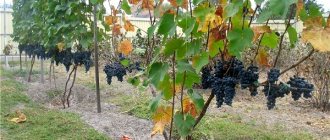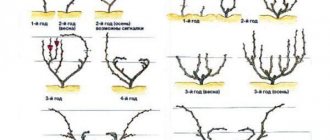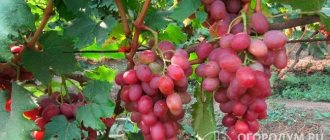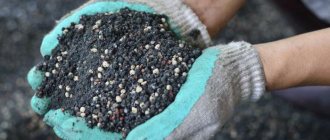The Everest grape was bred by amateur breeder Evgeniy Georgievich Pavlovsky. The created hybrid variety is truly successful and worthy of special attention from farmers and winemakers. Everest berries are distinguished by their aroma and bright taste, as well as an excellent ratio of grape acids to sugars. This relatively new table variety is actively used not only as a raw material for winemaking, but is also often consumed fresh. The parent pair “talisman” and “k-81” provided the hybrid in question with excellent taste and commercial qualities, as well as relatively high frost resistance and resistance to dry periods.
Berries
The fruits have a uniform, beautiful pink color. At the beginning of ripening, the grapes appear tinged with a slight addition of pink. When fully ripe and overripe, the berry of the hybrid in question acquires a dark burgundy hue. It is important to note that the fruits of the Everest grape variety tend to fade slightly in the sun, while the shadow side preserves the brightness of the color. Given this property, farmers are in no hurry to open the berries to the sun's rays.
Not all berries begin to acquire their color at once, but only those that have already gained a mass of at least 15 grams. Other grapes ripen patiently and only then catch up in color to the first ones. Ripe berries weigh on average 18–20 grams each. However, the scales sometimes indicated the weight of Everest grape fruits up to 25 grams.
The shape of the grapes is oval with a slightly narrowed tip, the length of the berries is 4.5 cm, and the seed is 1 cm long. Initially, it may seem that the fruits are incorrectly formed, but the proportions are still respected.
According to the tasting assessment (the photo of the Everest grapes also indirectly confirms this), the hybrid is defined as a plant with an attractive appearance and harmonious taste. The skin gives the berry fruity notes; it is medium in thickness, but perfectly chewable. There is practically no nutmeg taste. The proportion of sugars and organic acids is balanced. All this makes the hybrid pleasant to eat both for lovers of sweet varieties and for those who do not like to taste sugar.
Advantages of the variety
This berry always attracts the attention of buyers.
The fact that “Everest” declared itself from the first years of its life as a promising form can be seen from its undeniable advantages:
- excellent presentation;
- excellent product yield;
- excellent durability after removal;
- no shedding of berries;
- no cracking of berries;
- good taste;
- early maturation.
Disadvantages of the form
- unstudied frost resistance;
- maintenance in cover culture;
- need for large areas.
Reviews from winegrowers
What a dessert!
Describing the hybrid form of the Everest grape, winegrowers divided their opinions into approximately the following categories:
- those who believe that the form has almost standard indicators - 28%;
- those who consider their shape to be very good and are not going to leave - 43%;
- those who believe that the form is good, and that shortcomings can be measured - 29%.
Landing Features
A seedling of the Everest grape variety is planted in a hole of standard sizes.
There is no point in trying to have a high yield on soils that are initially poor in nutrients.
When planting Everest seedlings, you should understand that minerals and organic substances are needed both for the vigor of shoot growth and for the formation of huge bunches and berries. That is why pre-planting preparation of the pit is so important for further cultivation of the form.
Grapes, a culture of more than one year. Once planted, you can reap the harvest for decades and enjoy the taste. Therefore, when planting, you need to dig a hole of at least one meter, remove the soil and fill it with freshly prepared nutritious soil mixture with additives of both organic and mineral substances.
When choosing a form, you need to constantly remember about agricultural technology; it is this that will allow you to enjoy a good harvest.
The author describes the main properties of the resulting variety (see table). At the same time, he makes a comparison with the original varieties that served as the parent form. These indicators turn out to be quite interesting.
| The name of indicators | Parental varieties and the resulting hybrid | ||
| K-81 (Cardinal) | Mascot | Everest | |
| Ripening period (counted from the moment the buds appear in the spring until 85% of the berries in the bunches reach consumer maturity), days | 105…115 | 125…135 | 115…120 |
| Bunch weight (average value), g | 500…850 | 800…1050 | 850…950 |
| Berry weight, g | 7…10 | 12…16 | 18…22 |
| Size (cm) and shape of berries | 2.2..2.5 2.4…2.7, spherical | 2.8…3.0 3.3…3.5, spherical, slightly elongated | 3,4…3,7·4,0…4,6, spherical, slightly elongated |
| Sugar content, % | 14…17 | 16…18 | 15…18 |
| Berry color | dark burgundy | light yellow, found with shades of pink | dark burgundy, found with bright red shades |
| Juice content in berries, % | 86…92 | 90…92 | 89…92 |
| Aroma (according to experts) | pleasant, discreet, reminiscent of nutmeg | pleasant, slightly enhanced, light nutmeg | pleasant, slightly enhanced, pronounced nutmeg |
| Recommendations for use | table variety, can be used in canning and making wine | table grade, can be used in canning and making sparkling wines | table grade, can be used in canning and making juices and wine |
| Flower functionality | bisexual | Female, pollinators required | bisexual |
| Vineyard bushes | vigorous | vigorous | medium height |
| Frost resistance, ⁰С | -22…-24 | -23…-25 | -22…-24 |
| Disease resistance | high | average | high |
| The need for shelter for the winter | covering is a mandatory agrotechnical operation | covering is a mandatory agrotechnical operation | covering is a mandatory agrotechnical operation |
Naturalists provide interesting information about the Everest grape hybrid in the videos offered.
Bunches
Many farmers note that Everest grapes have beautiful symmetrical clusters, dense, with long branches, voluminous and slightly elongated. They reach a length of up to 35–40 cm and a weight of about 0.7–1 kg. In a bunch, the grapes hang very tightly to each other.
Harvesting occurs in 3–4 years. Even without the formation of a sufficient amount of wood, the Everest grape bush produces clusters weighing up to 1.2–1.5 kg. However, during this period, the appearance of uneven shoots can be observed. One bush can produce both very large clusters and those that weigh no more than 0.5 kg.
Good pollination of the crop allows you to get a large and beautiful berry, but only after good thinning. The shape of the vine is conical with well-defined wings.
Reviews of Everest grapes
Malikova Anastasia Fedorovna, 47 years old, Kaluga
I took a cutting of the Everest grape for testing 2 years ago. This year I got a harvest. As indicated in the description, the berries are large, larger than a ruble coin, some even resemble plums in size. The color is pinkish-red. The taste is neutral, not sour and not cloyingly sweet. The clusters were small, 700 g each. I will continue to monitor the variety until I find any shortcomings.
Stepanov Efim Anatolyevich, 41 years old, Balakovo
I purchased several Everest grape bushes at once and have been cultivating them on my plot for 4 years. During this time I can note resistance to diseases, there are no signs. I liked that the thick peel does not crack during heavy rains and does not attract wasps. This makes it possible not to rush into harvesting and let it ripen. I collected 4 kg of berries from one bush with an average load.
Krasin Valentin Dmitrievich, 56 years old, Rostov-on-Don
I grow grapes for wine, and on the recommendation of a neighbor I decided to experiment with the new Everest variety. In the spring, I removed excess flowers and combed the brushes. At the end of August, the clusters of these grapes began to ripen. I left them on the vine a little longer. Although the grapes are large and tasty, their sugar level is too low for wine. But you can safely put such a berry on the table - a beautiful and very large grape with only two seeds.
Marketability
According to the description of the Everest grape, the berry has high rates of transportability. The medium-thick skin protects the fruit well from negative environmental influences and all kinds of damage. The berries can easily withstand long-term transportation and are stored well.
One of the special characteristics of this hybrid is its attractive presentation. At the market, such bunches are hard to miss and pass by. According to the description of the Everest grape variety, the fruits are:
- do not crack;
- stay on the bush for a long time, without changing their organoleptic properties;
- have high transportability even over long distances;
- They are stored for a long time after being cut from the bush.
A distinctive feature of the hybrid berries when ripe is that after “sagging” for up to 30 days, they soften a little at the tips, this indicates over-ripening. The state of over-ripening is not a minus for the fruits of Everest grapes, but it is better to pick the berries on time, according to the ripening period.
Botanical description
The Everest grape was bred by the famous breeder E.G. Pavlovsky by crossing the varieties Talisman and K-81. The hybrid ripens in the mid-early period - in the last ten days of August or September. The period from bud break to harvest is 110-120 days.
The Everest variety has a table purpose. The clusters are large, weighing 700 g, in the shape of a cone or cylinder, of medium density.
The bushes have great growth vigor and form powerful shoots. The flowers are bisexual, planting pollinators is optional.
Description of the variety and photo of Everest grapes:
- large berries;
- average fruit weight 12 g;
- oval shape of berries;
- red-violet color;
- thick waxy coating.
The berries are distinguished by their fleshy and juicy pulp. The taste is simple but harmonious. The fruits are not subject to rotting and cracking. Berries on one bunch may differ in size and color.
After ripening, the clusters can remain on the bushes for a month. After aging, the taste only improves, and nutmeg notes appear in the berries.
Read also: The best varieties of Chinese cabbage: a review for different climate types
Everest berries are consumed fresh and used for making desserts, jams, and juices. The fruits tolerate long-term transportation well.
Taste
The taste properties of the Everest table variety are good, the fruit pulp is juicy and even slightly crunchy. The skin is well fused with the pulp, has medium thickness and is quite easy to chew. There are no more than two seeds in each grape, and they are easily cracked without emitting bitterness. The fruits gain sugar quickly, and the balance of acids in them is such that even at the beginning of the ripening period they acquire a pleasant taste and do not become sour. Subsequent ripening of the fruit only improves its taste.
Tips on agricultural technology for grape culture
- If there is an excess of moisture in the soil, you should apply dry wood ash under the grape bush as often as possible, then the yield will increase by 10-20%, and the incidence of this bush with fungal infection, on the contrary, will greatly decrease.
- You need to water the grapes until the period when sugar prevails over acid. If you water the grapes during the period of intensive ripening, they will become less sweet and their shelf life will be shortened.
- To improve the ripening of problem grape varieties, it is necessary to increase the amount of active temperatures. This can be done by planting bushes with a problem variety along a stone or brick wall, which will give off additional heat to the plant at night.
It is also possible to form sleeves on single-plane trellises, where the load on the bush with fruits is reduced and the ripening time is correspondingly reduced.
Another trick that winegrowers use to additionally obtain active temperatures for the vines is to stretch the first trellis no higher than 40-50 cm from the ground level. Such a low arrangement of vine branches on the trellis adds to the total active temperatures of about 200-300 degrees and also contributes to better and faster ripening of grape varieties with these problems.
Advantages and disadvantages of the variety
According to the description, the Everest grape variety, the photo of which is presented below, has the following advantages:
- farmers can count on an early and stable harvest;
- grape berries have an attractive appearance and excellent taste;
- no tendency to pea;
- there is no rapid cracking of fruits;
- excellent rooting of cuttings;
- high adaptability to all kinds of climatic conditions;
- resistance to major diseases and damage by pathogenic microorganisms;
- the crop is transported well.
Let us also highlight the disadvantages of the variety:
- still unstudied winter hardiness;
- the crop should be additionally insulated;
- A huge area is required for cultivation.
New hybrid forms of grapes E.G. Pavlovsky (video)
Gesha
A plant from crossing the “Talisman” vine with the “Sprinter” and “Khodzhibey type” grapes. Super early in terms of full ripening. The plant produces bisexual flowers. The clusters are large, weighing 0.5 kg. The berries are large, weighing up to 11 grams, oval-elongated in shape and dark, bright red in color. The taste characteristics are high. A nutmeg aroma and increased levels of sugar accumulation are observed.
The grapevine is characterized by resistance to damage by major fungal infections. Winter hardiness is limited to minus 24°C.
Juliet
A plant from crossing the vines “Demeter” and “Nistru”. Mid-late ripening period. Vine with strong growth, produces bisexual types of flowers. The berries have an oval-elongated shape, large, matte, with a harmonious taste and a weight of about 15 g. The clusters have a pronounced conical shape, weighing from 0.5 to 1 kg.
The grapevine is resistant to mildew, oidium and gray rot. Winter hardiness is limited to minus 23°C.
Marshmallow
A plant from crossing the “Talisman” vine and the “Pridorozhny” grape variety. Early dates for mass ripening of the crop. The plant is vigorous and produces bisexual flowers. The bunches weigh 0.5 kg. The berries are super large, oval-elongated, reddish-violet in color, weighing up to 15.0 g. The taste is harmonious. The grapevine is resistant to mildew, oidium and gray rot. Winter hardiness -23°
Hummingbird
The plant was obtained by crossing the varieties “Hybrid-41” and “Baklanovsky”. Early-medium period of full maturation. The plant is vigorous, forms bisexual flowers and clusters weighing 0.5 kg. The berries are round-spherical, reddish-violet in color, weighing more than 15.0 g each.
The taste is harmonious. The grapevine is resistant to low temperatures and fungal diseases.
Master
The result of crossing "Hybrid-41" and "Talisman". Very early dates for mass ripening. The plant is vigorous and produces bisexual flowers. Bunches weighing 0.5 kg. The berries are oval-elongated, weighing about 12.0 g and dark red in color. The taste is harmonious. The grapevine is resistant to mildew, oidium and gray rot. Winter hardiness indicators – down to minus 24°C.
Subtleties of landing
According to reviews, descriptions and photos of the variety, Everest grapes are propagated by seeds, cuttings, by grafting cuttings to seedlings or by grafting another variety. The second method takes a significant amount of time. Many winegrowers initially sow seeds in a plastic or peat pot. When the young grapes reach a height of 10–15 cm, they are transferred to open ground. This process takes on average 2–3 years.
Propagation by cuttings is quite feasible only if there is already at least one Everest grape bush on the site. To do this, one or more strong vines are bent down and covered with soil. Reproduction in this way is recommended in spring or autumn.
Many farmers recommend planting the unpretentious and undemanding Everest variety in the second half of April. The planting site should be found on a hill with normal protection from the wind and good lighting, which is important for crop formation.
Almost any soil is suitable for growing crops. "Everest" can successfully produce crops even when growing on rocky slopes. The main advice is to avoid close proximity to groundwater and places where spring flooding occurs.
According to the experience of many farmers, the crop likes to grow best on the south side. When forming holes for planting grapes, half a bucket of humus is placed at the bottom.
Planting and caring for Everest Pavlovsky grapes
It is advisable to purchase seedlings of the Everest grape variety from trusted suppliers. This guarantees the absence of plant disease. Everest grapes have still been little studied, but there is already a list of recommendations for caring for them to get a good harvest.
Selection and preparation of a landing site
In order for the Everest grapes to ripen and gain sugar, sunny areas are chosen. The bush loves warm areas located on a hill or in the center of a hill. In colder climates, choose a site on the south side of a fence or house, protected from the wind. You cannot plant vines in lowlands where cold air and water accumulate.
Everest is not good friends with fruit trees and shrubs. It needs to be planted at a distance of 3 m from other plantings. This way the bush will receive a sufficient amount of nutrients and will not be shaded by the crown.
Fertile soil is preferable. Acidic or, conversely, highly calcareous soil is not suitable for Everest.
Advice! Before planting grapes in the spring, you can sow peas or other legumes in this area. And in the fall it is buried to a depth of 20 cm. This is a natural way to enrich the soil before planting grapes.
Landing rules
The best time for planting is mid-autumn, before the onset of cold weather. During this time, the young bush will have time to take root and successfully overwinter. It can also be planted in the spring after the snow melts, but in the fall it takes root better. Everest grapes are planted either as a separate bush or on other varieties.
A healthy seedling has 3 buds, about 40 cm long, and the thickness of the branches is 0.5-0.7 cm. The seedling should not have cracks, spots, roots without growths.
When planting grapes, perform the following work:
- A hole is dug 0.6 m deep and 0.6 m in diameter.
- Crushed stone or expanded clay is placed on the bottom as drainage.
- Prepare an earthen mixture: 2 kg of wood ash, 3 buckets of humus, fertile soil.
- The mixture is poured into the pit, covered with polyethylene on top and left for 3 weeks until settling.
- A seedling is planted, watered abundantly and the root zone is mulched with straw or humus.
Watering and fertilizing
Water the grapes until they are 3 years old. The first watering occurs at the time of bud break, then shortly before flowering and another watering during the ripening of the Everest clusters. A bush older than four years is capable of obtaining its own moisture from the soil. Warm water kept in barrels is suitable for irrigation. It is important to ensure that a lot of moisture does not accumulate at the roots. High humidity inhibits the growth of the vine, leads to rotting of the roots and the appearance of cracks in the berries.
Advice! In late autumn, it is better to water any Everest grape bush generously. This procedure will prevent freezing and help the plant endure the winter better.
Fertilizing is necessary to improve the quality of the crop. They use both natural and mineral supplements. The first fertilizing occurs for 2-3 years, if fertilizers have been placed in the planting hole. Everest is fed according to the following scheme:
- Nitrogen fertilizers in the spring when the buds open. Water in a ratio of 1 to 20 with a solution of mullein or urea.
- After flowering, the leaves are treated with a solution of 10 liters of water, 0.1 kg of superphosphate and 0.05 kg of potassium salt.
The treatment is repeated after the ovary. Attention! The application of phosphorus fertilizers stimulates the ripening process of bunches and retains sugar in the berries. And potassium helps reduce the acidity of the pulp and prevents rotting of the berries. - Digging up the soil in the fall with the addition of humus, 2 buckets per square meter, to restore the strength of the grapes after fruiting.
Trimming and shaping
To balance the load on the bush in the fall, pruning and crown formation are carried out. For Everest grapes, it is enough to leave 4 vines with 8-10 eyes each. Cut off the shoots after the leaves fall. With the onset of spring, the bushes are inspected and all dry and frozen areas are cut out.
In summer, grapes require thinning. To do this, cut off the stepsons, leaves covering the brushes. It is advisable to leave 2 inflorescences per shoot. With such a load, the grapes will ripen quickly, and all the clusters will be large.
Preparing for winter
The frost resistance of the variety has been poorly studied, so it requires shelter for the winter. In late autumn, after the leaves have fallen, the vine is removed from the supports and laid on the ground. As soon as the ambient temperature drops below + 5 °C, the ground around the bush is mulched with dry leaves. Metal arcs or wooden boxes are installed on top and covered with burlap or agrofibre. After snow falls, the shelter is covered with it, forming snowdrifts.
Attention! Air exchange is important for grapes, so they should not be covered with plastic wrap.
In spring, it is important not to miss the moment and remove the shelters in time. Increasing temperatures can cause the grapes to rot.
Grape resistance to frost and disease
Today it has not yet been clarified whether it is possible to obtain a normal harvest if the crop is planted in the northern regions of the country. Therefore, it is impossible to declare 100% that “Everest” is completely frost-resistant.
Winter hardiness, according to reviews of Everest grapes, has not yet been sufficiently studied. Since the hybrid was created relatively recently, many experts have not yet had time to study it well. To avoid crop loss, farmers advise that the plant be insulated for the winter. In autumn, when the first frost occurs, it is important to wrap the grape bushes using the dry method. That is, the vine is carefully rolled up and placed on pre-prepared boards. The branches are covered with several layers of non-woven material. Many farmers cover the vines with dry sawdust. After the branches have been insulated, be sure to construct a top layer of film or roofing material; it will help protect the crop from moisture.
The first treatment measures should be carried out when young leaves appear. To do this, you can use “Tiovit Jet” in a dosage of 40 grams per 9–10 liters of water. Such treatment will prevent the development of diseases such as oidium, Phomopsis and rubella.
“Everest” did not show a tendency to be highly infected with diseases. The crop is not susceptible to dangerous diseases such as powdery mildew, mildew, and gray rot. However, the key to a high-quality harvest is precisely the preventive treatment of the crop. The presence of a dense skin reliably protects the juicy pulp from insects and small pests. Grapes are not afraid of bees and wasps.
Diseases and pests
The variety is noted to be resistant to major grape diseases with proper care and cultivation. Belongs to group 3 in terms of durability.
To prevent the spread of mildew, treat the bush with Reed. Topaz protects against powdery mildew and oidium. The solutions penetrate the leaves and bark of the vine and prevent the spread of fungus. Spraying is carried out according to the following scheme:
- first treatment with the appearance of the first leaves;
- second spraying 2 weeks after flowering;
- autumn treatment 3 weeks after harvesting.
If the bush is sick, it is treated additionally. The maximum number of sprayings is twice a month.
Among pests, Everest grapes are attractive to:
- spider mite;
- gall midges;
- leaf mite;
- Khrushchev;
- leaf rollers.
For prevention, bushes are sprayed against insects with chemicals Aktara, Karbofos, Aktellik in the spring and autumn. During active growth, handle with caution.
Prevention measures
In order to protect plants from insects, rodents and fungal infections, preventive measures can be taken. The first thing experts do is spring spraying of the vines and soil. To do this, use a 3% solution of iron or copper sulfate.
The second spraying is carried out during the period of bud break and the appearance of the second leaf. To do this, take drugs with antifungal action. It is also necessary to carry out a third spraying of Everest grapes before flowering begins, for which they use “cocktails” of antifungal drugs, insecticides and foliar feeding.
Subsequent spraying of the bushes is carried out only as diseases appear, and also taking into account the epidemiological situation in the grape growing region. If specialists carried out prevention in a timely and competent manner, then further spraying may not be useful. As can be seen from the article, there is nothing difficult about growing Everest grapes.
Formation of the crop and its harvesting
Winegrowers note that the first clusters are formed in the second year, and from the third year the stable formation of marketable grapes begins. It is advisable to raise the bunches to a height of more than 70...80 cm from the soil level.
When growing in areas north of Moscow, it is advisable to place shrubs on the north side of the rows of grapes. They will cover the vineyard from the cold north wind. It is preferable to grow currants or raspberries.
Harvesting is carried out as it ripens.
- In the Rostov region, the harvest is ready for harvest in the second ten days of August.
- In the Kursk and Oryol regions, “Everest” ripens by the end of August.
- In the Tula, Ryazan, Kaluga regions and Moscow region, ripening occurs in the first ten days of September, and in some years it may be in the second ten days.
Features of agricultural technology
Grapes Nadezhda Aksayskaya
It is difficult to imagine a better grape variety for the Voronezh region than Mukuzani. However, if desired, it can be grown in more northern regions of Russia. To do this, you will have to compensate for the not very suitable climate with rich, fertile soil. Caring for grapes of this variety is not much different from how to care for other varieties that do not require shelter.
Disembarkation
For grapes, soil with neutral acidity will be optimal. It is necessary to first add complex mineral fertilizers. Two weeks before the seedlings find their permanent place in the ground, it must be dug up, weeds must be removed and the larvae of all insects destroyed. To plant cuttings, you need to choose a warm spring day so that the first period of adaptation of the plant takes place in mid-spring.
Planting grapes
Two or three days before planting in the ground, the seedlings stop watering so that a lump of earth forms around the cuttings. In a trench that has been prepared in advance, planting holes are made with a diameter of 30 cm and a depth of 25-30 cm. Fragments of red brick, or just lumps of clay, are placed at the bottom of the hole. Fertile soil mixed with fine sand is poured on top of the mound. The plant, along with a lump of earth, is placed on a mound. Before filling the planting hole, place a handful of ash in the root area. The hole is filled up to the second eye of the cutting. Planting is completed with abundant watering.
Note! Some experienced winegrowers add a handful of barley to the hole, under the roots of the plant. It is believed that the cereal will help the roots to gain a foothold.
Trimming
Mukuzani grapes need regular thinning of bushes and pruning of excess shoots. If this is not done in time, the berries most likely will not ripen completely, and the development of the vine will be uneven. Spring pruning of uncovered grape varieties is carried out in the first or second ten days of March, depending on the duration of winter. This operation must be performed before the buds swell and intense sap flow begins. During the winter, some shoots freeze and need to be removed.
Grape pruning
In the fall, the vine is pruned so that it is better prepared for winter.
Breaking off
First of all, underdeveloped shoots growing from below are broken off. Double and triple shoots are also subject to removal. The most developed shoots remain and thanks to them, subsequent rejuvenation of the bush occurs. This operation, along with pinching, allows you to regulate the future harvest.
Topping
To prevent the plant from stretching in length, the tops of green shoots are removed. As a result of this operation, the main flow of nutrients will be directed to the inflorescences. This needs to be done two or three days before flowering.
Pinching grapes
Weeding
In order for the vineyard to develop normally, it needs to be weeded regularly. Near the vineyard there should be no weeds or extra plants that feed on grape juice. The top part of the soil can be periodically replaced with new, more nutritious soil.
Pest Control
Vineyard protection from pests should be carried out systematically, regardless of whether insects are present on the plants or not. Moreover, this should be done before the flowering period.
Currently, there are few diseases and pests in the northern regions of Russia. Mainly northern vineyards suffer from powdery mildew (oidium). Those who want to get an environmentally friendly harvest can be advised to use biological products instead of “chemistry”. Russian winegrowers treat oidium with a ten percent infusion of mullein. In the USA, a new method has recently been developed to combat this disease, which involves the use of a whey solution.
Additional Information. If you plant a rose at the ends of the trellis, it will be the first to signal the onset of the disease and the need to take certain measures.
Main characteristics
"Everest" is characterized by a short growing season. From the moment the buds open, the fruits ripen after 120 days. This allows you to harvest ripe and juicy fruits already in mid-August.
Bushes
The Everest variety takes root well and easily adapts to environmental conditions. The bushes are characterized by good growth vigor and excellent ripening of the vine along the entire length. The formation of a large number of fruit-bearing stepsons greatly facilitates the reproduction process. However, due to the presence of large bunches, it is necessary to monitor the load on the bush and prune it on time.
Flowers
The presence of bisexual flowers has a beneficial effect on the process of reproduction and development. This allows the plant not only to pollinate itself, but also to participate in the pollination of other crops. The proximity of “Everest” to grape varieties with unisexual flowers is very advantageous.
Bunches and berries
Large clusters of grapes deserve special attention. They have a cylindrical shape and a dense structure in which the berries are located close to each other. The weight of an individual bunch varies from 0.6 to 1.2 kg.
The berries are large, oval in shape, weighing 15-25 g. The pulp is juicy and dense, covered with a thin but durable skin that is barely perceptible while eating. The amazing dark red color of the berries, covered with a thick pruin coating, gives them a chic appearance. “Everest” received excellent taste thanks to its pleasant sweet taste and harmonious aroma.
Productivity
High yield rates never cease to amaze winegrowers. Excellent commercial qualities and appearance allow the variety to be bred for personal use and for sale. Beautiful and large fruits are just beginning to conquer the market, but the demand for them is increasing every year.
Transportability
Bunches of grapes have good transportability. The reliable skin perfectly protects the berries from external influences and damage. The fruits can easily withstand long-term transportation and are stored well.
Frost resistance
Due to little study of the variety, the frost resistance threshold of grapes is not known. However, Everest has proven its resistance to slight cold and frost. This allows the crop to be grown not only in the southern but also in the middle regions.
Advice! In order to prevent and protect the plant from freezing, it is recommended to cover the bushes for the winter. The reliability and durability of the covering material depends on the climatic conditions of the area.
Resistance to diseases and pests
Everest did not show a tendency to be highly susceptible to diseases. It is not susceptible to the most dangerous diseases, such as oidium, mildew, and gray rot. However, the key to a high-quality harvest will be preventive treatment of grapes. The presence of a dense skin reliably protects the juicy pulp from insects and small pests. Grapes and wasps are not afraid.
Northern sweet, variety description
The shoots of northern sweet grapes are distinguished by their great growth vigor.
The vine is characterized by good ripening. This provides high winter hardiness to the bushes. Northern sweet tolerates low temperatures down to -30 degrees. Northern Sweet is a technical variety with a medium ripening period. For the berries to ripen from the moment the buds open, the variety needs about 130 – 135 days. In the southern regions, harvesting begins at the end of August - the first ten days of September. In the conditions of the Moscow region and more northern regions, the berries ripen by September 15–20.
The brushes are moderately dense, weighing from 80 to 120 grams. The berry is round. Weight is no more than 1.5 g, although under favorable conditions it can be 2 g. The color of the berries is dark blue or blue-violet, with a waxy coating on the skin. The skin is strong, but rather thin. In the southern regions, the sugar content is high, from 23 to 25%.
With an acidity of 6-7 g/l. In more northern regions, acidity can be higher and reach 8–11 g/l, while the sugar content is no more than 19–21%. The pulp is juicy, sweet and sour, the taste is quite harmonious. The separation of seeds from the pulp is satisfactory. The advantages of the northern sweet variety include:
- productivity
- frost resistance
- good ripening of shoots
- high resistance to oidium and other diseases
As a disadvantage, it is necessary to note the deterioration not only of taste, but also of yield due to lack of water. Despite the fact that many amateur winegrowers note the ability to withstand frosts down to -36, still in the northern regions, as well as in the Urals and Siberia, it is better to grow under light cover or lay the vines on the ground. They will be covered by fallen snow.
The harvest of northern sweet berries can be a good basis for aged homemade wine with a rich, pleasant taste. The climate of most regions of the country is characterized by fairly short and cool summers, few sunny days and low negative temperatures in winter. To get a harvest in regions with such a climate, you need to know about some secrets of growing northern sweet grapes.

